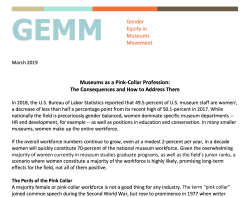The Silent Treatment (and what to do about it)
Posted: February 12, 2018 | Author: leadershipmatters1213 | Filed under: Communication, Leadership, Leadership and Gender, Museum, Nonprofit Leadership, Workplace Bullying | Tags: career, museums, nonprofit, soft skills, workplace culture |6 Comments
Before we begin this week, let me express our profound sadness in light of the Berkshire Museum agreement with the Massachusetts Attorney General’s office. While it is wonderful that Norman Rockwell’s Shuffleton’s Barbershop will remain in the public domain, the decision seems to leave the door open for any museum to use its collection as a trust fund. If a board expresses fundraising fatigue or fear that a major campaign will not make its goal, it can always look for something to sell. So those of you who are museum leaders, think carefully about how you will respond when a board member’s response to a big capital expense is, “Can’t we just sell our Frederick Church painting?” What will you say? Is referencing AAM’s ethical standards enough? Was it ever enough? Or was it the last leftover from the age of museum patriarchy and gentle person’s agreements?
******
Apart from deaccessioning, we wanted to talk about executive directors who don’t use their words. We’ve written here about directors who can’t stop talking, but this is the opposite. To be clear, this isn’t a judgement on personality. Some directors are not Chatty Cathys. This is about leaders using silence with negative effects.
Think that doesn’t happen? Were you never in middle school or worse in a relationship where someone stopped speaking to you? This is the workplace equivalent of that. Sometimes this happens when new leaders worry about separating emotions from words. They don’t want to yell. Women, in particular, don’t want to yell because studies show us that an angry woman at work is judged much more harshly than an angry man. As a result, they don’t say anything. Or worse, a leader approaches staff weeks after something went badly, and by then it’s too late.
So silence is used to guard against anger and emotion, but there are also leaders who use silence to ostracize staff. They forget to tell them things; they don’t read weekly reports or share important news. As a result, staff find it increasingly hard to complete tasks because museum workplaces run on information. If a major benefactor is waffling, but no one tells you; if there are four candidates for the curator’s position not three, and so on. Incomplete tasks mean poor progress for individuals, departments and museums as a whole.
But for a staff member who tries to explain what’s going on, silence is a deviously tricky weapon. It is after all a sin of omission. No one yelled at you, no one’s overtly hurt you, so what’s the big deal? In fact, silence, coupled with ostracism is the polite form of workplace bullying, and far more common than bullying itself. A 2014 survey by the University of British Columbia of American workers, found that ostracism is far more common (71%) than harassment which was experienced by only 29%.
So what should you do?
- Marshal your facts. Are you the only one who’s being left out and not spoken to? Admittedly, it’s cold comfort, but at least it’s not you.
- Is there a work colleague you can speak with who might shed some light on your departmental or museum work culture? Are you not being spoken to because you’re not being noticed or is it more deliberate than that?
- Is this something only you notice or has your work colleague observed it too? If not, don’t think you’re being gaslighted. Your work experience may not be theirs.
- Channel your inner Michelle Obama and “When they go low, you go high.” Put your game face on. Stay positive in public. Be prepared. Speak up when you know something. Don’t let ostracism and silence lead you to doubt yourself. That said, keep a log describing when and how the silent treatment occurred.
- The last, and the hardest step is to confront the person. If it’s your ED, you may want to go to HR first, but don’t be surprised if you don’t get much of a reaction. HR sometimes doesn’t realize how hard the silent treatment can be. If it’s a co-worker who’s shut you out, be prepared for the fact that she may not admit what’s happened. Plan, but don’t script your conversation, and make sure your goal is to come away with a resolution.
It’s February. If there ever was a month where we need our words, it’s this one. Use them. Communication builds trust, trust builds loyalty. Together they create a hothouse of creativity and a happy staff.
Joan Baldwin










How many museum’s actually have HR? I’ve never worked for one that does and I am currently at a large institution.
Kaya–
Sadly, you’re correct, and there are not as many as one would like. Without an HR department, an organization likely has a person who deals with issues of benefits, and salaries, yes? That still doesn’t mean that’s the person to deal with disputes or whether that person is at all skilled. If that’s the case, you may need to go outside and talk with a professional first–a lot of that depends on the nature of the complaint.
J. Baldwin
I worked at a small organization where the whole organizational culture was very similar to how you described. Instead of just being about select people being ostracized, that was what everyone experienced from time-to-time. Everything was need-to-know and compartmentalized, with the consequence that you’d miss out on major news and events. Some of the things you were excluded from would almost feel spiteful, because there was no reason to not tell you and all it did was serve to make you feel like you didn’t belong. I’d finish major projects or submit something and would get no feedback unless there was a problem, not even a confirmation that it’d been received. There was just 0 communication unless there was a problem. That was always communicated. The director was a no-nonsense type who didn’t care how things made people feel and I honestly think that was just her management style. At first I thought it was just me (I was the newest staff member) until I had a very open conversation with coworkers who had been there for awhile, and they said they felt the same way. It was honestly the most toxic work environment I’ve ever had. I perpetually felt like I was on the outside looking in, like my contributions weren’t valued, and like I wasn’t wanted.
[…] The Silent Treatment […]
[…] still convinced WordPress made a mistake. It was followed by Leadership and Workplace Bullying and The Silent Treatment (and What to Do About It). That saddens me. Those posts were written in 2017 and 2018 respectively, and yet they are among the […]
[…] Rounding out the top five were Putting the Dipstick Down on the Museum Workforce, and finally, The Silent Treatment and What to Do About It, which talks about bullying’s passive aggressive twin, not speaking to each other. Like I […]